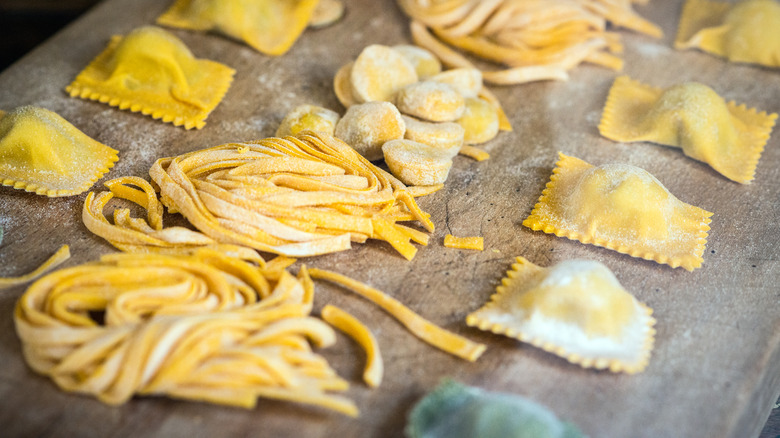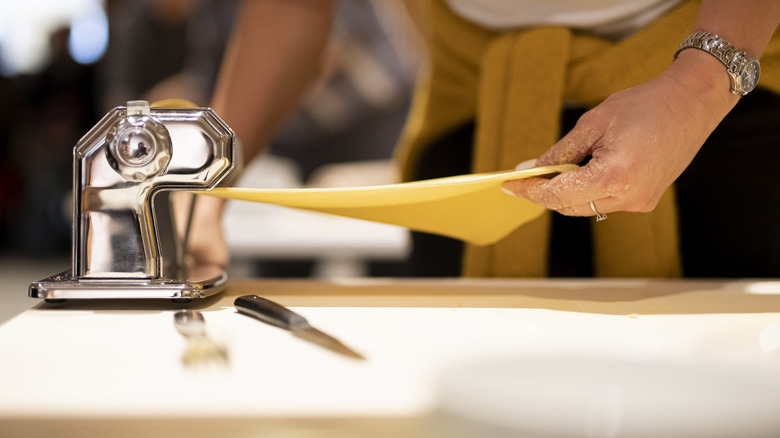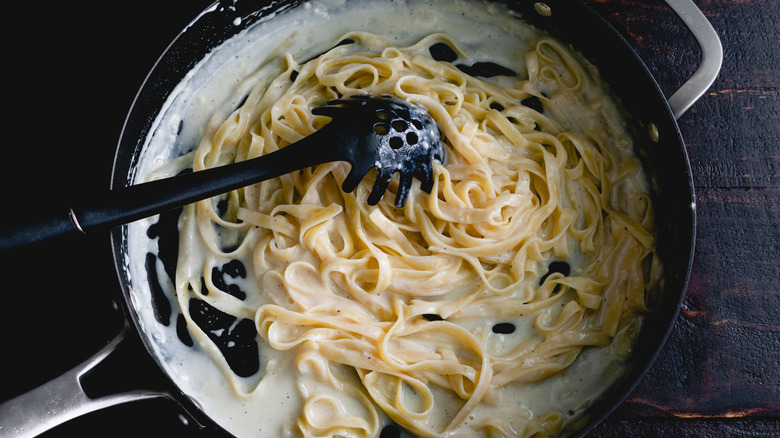Make Fresh Pasta Shine By Opting For A Lighter Sauce
Have you ever wondered why fresh pasta from your favorite Italian restaurant always tastes so much better than the kind you boil from a box yourself? The answer could lie in how it's prepared. Fresh pasta, when made from scratch, is never dried and boxed, so the flavor and texture are slightly different (and many would agree, better) than anything you'll find in a box from your local grocery store.
Thankfully, making fresh pasta dough is incredibly easy, but when you put in all that work, you want the pasta to be the star of the show rather than its sauce. No need to slather it in a dense sauce like a Bolognese; it will shine without much help. And for that reason, you should always pair it with a super light sauce, such as a pesto, or even just salted butter and Parmesan, known as "pasta al burro" in Northern Italy.
While a pasta maker might help move the process along, there's no reason to be intimidated by preparing your own homemade pasta by hand. It comes down to two basic ingredients, plus a few kitchen tools.
How to prepare fresh pasta
There is a reason boxed pasta costs so little — even making it at home is extremely cheap. Its two basic ingredients are flour and eggs; water is often included as well, though some people leave it out. You can use semolina, a durum flour, for thicker, heartier pasta, or use "tipo 00" flour, which is lower in gluten than semolina and creates a lighter dough. Plus, you'll want to season the pasta water with salt, so make sure you have a bit of that on hand as well.
Basic pasta dough recipes vary, but for the most part, the ratio is 1 large egg per 1 cup of flour. You can also add a bit of water if the dough feels too dry, plus a bit of olive oil to help the kneading process. Create a well with the flour and add in the (already whisked) eggs, then combine the four and eggs, and knead the dough until it's a smooth ball. This only takes about five to 10 minutes, depending on how much pasta you're making.
Don't forget to let it rest: Pasta dough should rest for 20-30 minutes before you roll it out. Once rested, roll the pasta dough out (or put it through the pasta machine) until it's thin, then cut it into individual pieces and boil for two to three minutes. Once your pasta is prepared, it all comes down to the sauce.
Choosing the best sauce for fresh pasta
You've put in the work and your pasta is ready to go, but now it's up to you to decide how you want to serve it. Don't forget that fresh pasta will have a more delicate texture and greater flavor than the boxed kind, so if you want it to truly stand out, make sure the sauce isn't the main character. Opt for a lighter sauce to highlight your efforts, whether that's a cream-based sauce with a bit of Parmesan or just some butter, fresh herbs, and black pepper.
Your sauce can change based on the pasta's shape, too — thicker kinds of pasta, such as pappardelle, can handle heavier sauces without the sauce overpowering the dish. If you're making a thin spaghetti, a light sauce such as a butter-based sauce with white wine or lemon is a better fit. Pesto, an herby, oil-based sauce, is another great light option.
Red sauce works, too, but try not to go with a sauce that's loaded down with meat or vegetables. A basic tomato sauce made from just tomatoes, fresh basil, and seasonings, is a good light option. Or, to truly highlight the fresh pasta's flavor, add a bit of sea salt to some olive oil, and toss the pasta in it. Serve it with only these two elements, and your guests will get a real understanding of the light, fresh texture and flavor of your homemade dish.


